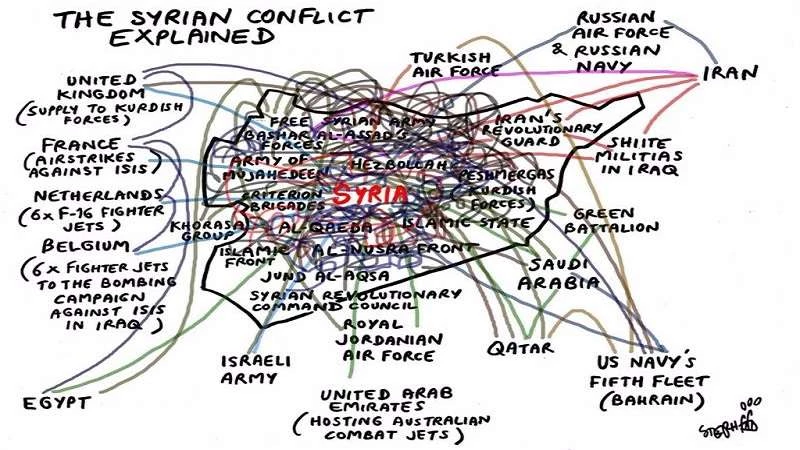In Syria, the regime labeled every one in conflict with it a “terrorist”. That even was not enough to justify its brutality; it had to work on designing a more brutal system that lends itself to a comparison with its crimes so that it can survive the severe criticism it subjected itself to after a long series of massacres it perpetrated against civilians; and Daesh as a result came into being. That was in no way a guarantee for its rehabilitation, let alone its survival. Hezbollah and even Iran could not do the job, either.
Being aware of the US strategy of indifference and of erasing its “red line” the regime could not survive without internationalizing the conflict; especially with what came to be known as the “Friends of Syria” group that exercised some pressure over it but not to the extent of internationalizing the conflict. At last, Russia came in, and very heavily. The US in turn has started to balance its strategy of non-commitment with the role it assumed after the Cold War.
The two “super” powers built on the coordination they struck regarding stripping the regime of its chemical weapons in 2013 and on being sponsors of the first “cease fire” in 2016. The International Syria Support Group (ISSG) somehow felt alienated. It held lately a conference on Syria in Paris, but Kerry rushed to it denying the group an independent effective status.
Each of the parties to the Syrian conflict, however, has its dilemma organically interconnected with the internal aspects of the conflict. The Russians are room mating the regime without getting into a marriage relationship. And as far as the opposition is concerned, the Russians are projecting a status of no blessing and no cursing with the exception of certain instances when they want to veto an opposition group out or in. To the Assad regime’s advantage, a sour relationship has developed between Russia and Turkey, the regime’s avowed enemy. In addition to this explicit conflict, an implicit conflict surfaced with certain Arab Gulf states over Syria. Those states do not mind a Russian role, but they themselves want a role with Iran being pushed aside as a threat to them and to Syria.
Beyond all these political hiccups, Russia has interests in Syria; it wants them guaranteed, and it has open disturbing files with those involved in the Syrian saga; it wants them settled.
When it comes to the United States, it does not explicitly stand as an obstructing block before those Russian interests, but in turn it wants a role, a decisive one without paying for it, i.e., a free ride unlike the Russians who went into combat while Obama has been conceptualizing for the past five years. The US has been counting on its super-power hood and monopoly over the Opposition and their supporters to have- if not a say- the say in what is to happen concerning Syria.
When Iran declares that it determines the destiny of four Arab capitals with Damascus on top under the pretext of projecting enmity with Israel, the Mullas portray the conflict over the regime as a matter of life or death. And if they want to let go, they demand things to go their way and this is another best description for making their conflict bloodier.
The general map of the conflict over Syria cannot take full shape without reference to Turkey and Israel. The first happens to have the longest borders with the area of conflict and the largest number of refugees resulting from the conflict. Turkey cannot simply tolerate this hostile support to the PKK which it considers to be a threat to its national security. Israel which has enjoyed over four decades of borders tranquility with the Assad regime cannot easily let go of such a regime. Israel has recently reopened the Golan file to reactivate its annexation resolution of 1981 with the pretext that Syria is in a state of fragmentation with no clear future.
All the above conflicts or sub-conflicts have contributed to the lengthening of the Syrian tragedy and played into the hands of a regime that has worked hard in making the conflict over not in Syria. Such a deadlock caused by multiple conflicting interests proves to be the best formula for the continuity of the Syrian catastrophic situation.
There seems to be no way out in the horizon. The stakes in the conflict are so high and the cost is unbearable to all the parties concerned.
With such a deadlock, all are down deep convinced − yet some of them never and would never explicitly express it- that the only solution for Syria is the ousting of the regime and a restructuring of the intelligence and military institutions. Such a step would be the introduction to tackling a multi-dimensional crisis. The second step would be the formation and establishment of a National Syrian Salvation Project (NSSP).



التعليقات (0)